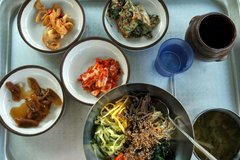Eat
HomeEat

Example of a Korean meal: bibimbap with (from left) pickles, eomuk jorim sauteed fishcake, kimchi, pajeon pancake, a pot of gochujang and doenjang soup. Image by jpatokal
Korean cuisine is becoming increasingly popular outside of Korea, especially in other parts of East Asia and the U.S. However, those unfamiliar with Korean cuisine will have to be wary for the many spicy and fermented dishes in Korean cuisine. Nevertheless, it is addictive once you get used to it and Korean food is definitely in a class of its own, mixing spicy chillies and copious amounts of garlic with delicate ingredients like raw fish. Although Korean food is quite low in fat, a fact attested to by the observation that very few South Koreans are overweight, those with sodium-limited diets should beware, as Korean cuisine can be heavy in salt.
A Korean meal is centered around rice and soup and likely a fish or meat dish, invariably served with a vast assortment of side dishes known as banchan (반찬). The humblest meal comes with three types while a royal banquet may well feature twenty types of banchan. In addition to kimchi (see below), typical side dishes include bean sprouts (콩나물 kongnamul), spinach (시금치 shigeumchi), small dried fish, and much more.
The ubiquitous kimchi (김치 gimchi), made from fermented cabbage and chili, accompanies nearly every meal and may be a bit of an acquired taste for visitors as it can be quite spicy. In addition to the common cabbage type, kimchi can also be made from white radish (깍두기 ggakdugi), cucumbers (오이 소박이 oi-sobagi), chives (부추 김치 buchu gimchi) or pretty much any vegetable that can be pickled. Many different dishes are made using kimchi for flavoring, and kimchi is served as a side dish as well. It is not uncommon to find Korean tourists carrying a stash of tightly packed kimchi when travelling abroad.
Two more condiments found in almost every dish are doenjang (된장), a fermented soybean paste akin to Japanese miso, and gochujang (고추장), a spicy chilli paste.
While many of these dishes can be found throughout Korea, every city also has its own regional specialities, such as dakgalbi (닭갈비) in the city of Chuncheon on the east coast. See the various city articles for more details.
A common perception amongst Koreans is that foreigners simply don't like spicy food, so you might have to spend some time convincing people otherwise if you really want to eat something hot. Also, while Korean food undoubtedly has the neighboring bland-dieted Japanese and northern Chinese breathing fire, if you're accustomed to (say) Thai or Mexican food you may wonder what the fuss is about.
Be aware that eating is deemed a group activity in Korea, and some restaurants may charge a little bit extra or up to double the stipulated price for a lone patron, or on rare occasions, be uneasy with serving them at all.
In This Section |
See Also |